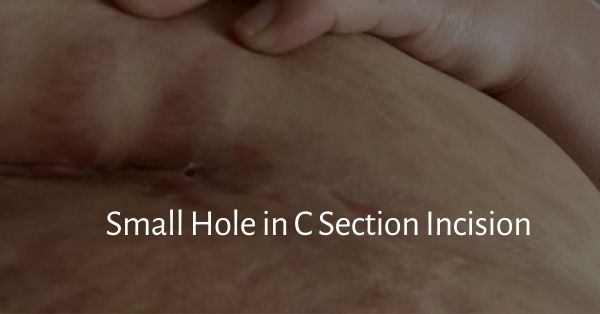We all know that a c section calls for major rest in order to give it a chance to heal properly. But with so many of us finding this difficult we battle with various problems during recovery. Finding a small hole in c section incision can seem alarming so stick with us to find the answers to what and why.

Small Hole in C section Incision – All You Need To Know
Usually, a small hole in the C section incision can indicate infection or a reaction to the suture materials used in the operating room. Finding a small hole in your c section scar is very rare, but it can happen. Either way, the best course of action is to get checked out by your doctor who will then start you on a course of antibiotics.
C Section Incision
You may not feel like a superwoman right now but you momma have just given birth through one of the most spectacular surgeries. A c section is a fairly common practice but this doesn’t take away from the fact it is still major abdominal surgery.
After surgery comes the healing process so how do you ensure that your body heals effectively? Even if you follow the tips and advice, what should you do if you find a hole in the incision after c section?
Why is There a Hole in My C Section Incision?

Finding a hole no matter how big or small can indicate the need for medical attention. Known as dehiscence, it could be the beginning of your wound reopening.
Finding even a tiny hole in a c section incision can cause major complications down the line. An open wound is susceptible to infection which if unnoticed or left untreated can make you extremely unwell.
The Impact of Nutrition on Wound Healing Post C-section ?
You’ve probably heard me say this before, but after having five kids, trust me, the importance of nutrition post C-section can’t be emphasized enough. It’s like fuel for our bodies, especially when we’re trying to heal.
Our little bundles of joy are a gift, and a C-section, while common, still is a major surgery. So, just as we nurture our babies, we also need to nurture our bodies to ensure we heal properly.
The Role of Nutrition in Wound Healing
Wound healing? Sounds complicated, huh? But break it down, and it’s pretty simple:
- Inflammation: Think of it as your body’s first responders on the scene. To tackle this, your body needs energy, protein, and a handful of vitamins and minerals.
- Tissue Formation: Here, we’re talking about the skin and blood vessels’ reboot. For that, you want protein, vitamin C, zinc, and some other buddies.
- Remodeling: The grand finale! Your new tissue goes through a strength training phase. And guess what? Protein, vitamin C, and zinc are at it again!
Key Nutrients for Wound Healing Post C-Section ?
- Protein: It’s like the building block for tissue repair. Think lean meats, fish, eggs, or even beans and nuts.
- Vitamin C: Your go-to for collagen. Oranges, strawberries, and bell peppers are your pals here.
- Zinc: A superhero for the immune system and healing. Grab some beef, beans, or nuts.
- Vitamin A: This one’s all about skin and its pals. Leafy greens, eggs, or even milk can help.
- Omega-3 Fatty Acids: These are the peacekeepers, keeping inflammation in check. Salmon and flaxseeds are great sources.
And hey, don’t forget about hydration. Water isn’t just to quench your thirst. It helps transport nutrients, maintain body temp, and toss out the junk. If you’re dehydrated, healing might hit a bump.
Is There An Issue with the Suture?
Typically your doctor will discuss with you the process of your c section and they will explain the style of suture they will use once your baby is born and you’re ready to be closed up.
There are several choices:
- Dissolvable stitches
- Glue
- Staples
- Removable stitches
If you notice that your wound isn’t healing as you would expect then it could be a reaction to either one of these methods. If presented to your doctor they may recommend closing the wound off again using an alternative method but be prepared this adds time to the healing train!
What Can Cause Holes in My C Section Scarring?

You have been warned, after delivery you need rest, your body is still recovering for up to 8 weeks after you birthed your child so make sure you practice those delegation skills!
Of Course, I would be naïve to think that all women stay in bed for 8 weeks so here are the main reasons why incisions can rupture.
- Heavy Lifting
Believe it or not, the only thing you should lift after a c section is your baby. Anything heavier and I mean lifting even a jug of water can cause stress on your stomach making it easier for your stitches to pull apart.
- Body Not Behaving
There are times when your body just doesn’t play the ball game. There is no known cause for uneven healing but one could think it has something to do with diabetes.
- Infection
If you are thinking my c section scar has a hole in it, then it could point to an infection, which is never pleasant and can lengthen your recovery. In fact, after a c section you are sometimes given antibiotics before surgery but it is not classed as common practice. Fighting infection and trying to heal can lead to a catastrophic healing process.
Sometimes infections just happen, microscopic bacteria and germs can get into your system and cause havoc while your immune system is firing on all cylinders to heal your wound from the inside out.
- Necrosis
This is where there is not enough oxygen or blood flow running to the incision site. Our bodies need oxygenated blood in our body to heal properly.
Lack of blood will result in a partially healed c section scar that can be very susceptible to infections and become gross and painful very quickly!
- Unusual Bleeding
After having a baby you expect your body to bleed and pass clots hence the surfboard style maternity wear you can buy. But you should pay close attention to their size, they should never be bigger than a half dollar.
Foul Smelling Discharge
So you may not be feeling very glam after your section but if you notice a foul smell then it could signal infection.
Treatment to Hole in C Section Incision
There are several different treatment options if you find a small hole in c section incision depending on the issues causing the holes.
- Re Suture
Your doctor will be able to determine where you have had a possible reaction to the first suture that was applied or where you have just over exerted yourself and tore the stitches.
No matter the outcome the holes will need fixing to allow the healing process to restart.
- Antibiotics
These will kick the infection up the butt and give your body back its fighting spirit, Lord knows it’s already doing loads! If you need to take antibiotics ensure you mention whether you are nursing or both as some meds can interfere.
All of these can be avoided by taking precautions post surgery but there are still possibilities these things can still affect your healing.
Take the style of c section you have. There is a choice between vertical and horizontal. Horizontal is the preferred method as it sits nicely in the pubic hair line and has a better track record of healing without issue.
Many doctors automatically perform the horizontal cut unless they have to cut vertically. It is what is best for you and your baby.
Postpartum Wound Care 101 ?
After birthing a new bundle of joy (I’ve done it five times myself, and boy, is it an adventure), our bodies need a little TLC, especially where those incisions were made. Whether it’s on your belly, thanks to a cesarean section, or down below after an episiotomy, proper care is the golden ticket to preventing infections and promoting swift healing.
Types of Postpartum Wounds
✓ Cesarean section incision
This one’s right in the lower abdomen where they deliver your precious one. Usually, it’s a horizontal cut (the bikini-friendly kind) or sometimes a vertical one, known as the Pfannenstiel incision.
✓ Episiotomy
Located in the perineum (that’s the stretch between the vag and your behind), this cut helps ease the baby’s journey into the world. It can run straight down the middle or off to the side.
Risky Business: Factors for Postpartum Wound Infection
- Preexisting medical conditions: Diabetes, obesity, and even anemia can up the risk of an infection.
- Labor marathon: The longer labor drags on, the higher the chance of bacteria getting cozy, leading to potential infections.
- Instrument intervention: If forceps or vacuum extractions get involved, tissue might be more susceptible to infections.
- Cesarean section: C-sections generally have a higher risk of infections than their vag counterparts. Just one of those things.
Red Flags: Signs of Postpartum Wound Infection
If you’re feeling like something’s off, here are a few symptoms to watch out for:
- Redness, swelling, or warmth around that incision
- Some unexpected pain or tenderness
- Liquid making an exit from the incision
- Running a fever or getting the chills
? Table: Signs and Symptoms of Postpartum Wound Infection
| Sign or Symptom | Description |
| Redness | The skin around the incision looks angry and inflamed. |
| Swelling | The skin around the cut is puffed up. |
| Warmth | The skin feels like it’s got a mini heater on. |
| Pain or tenderness | It’s sore when you touch it. |
| Drainage | Some liquid or goo oozing out. |
| Fever | You’re burning up, hotter than 100.4°F. |
| Chills | You’re shivering even when it’s not cold. |
Tips to Show Your Wound Some Love ?
- Give it a good clean with soap and water.
- Pat it dry gently.
- Slather on a bit of antibiotic ointment.
- Pop a clean bandage over it.
- Replace that bandage if it’s wet or dirty.
- Elevate those legs when chilling out.
- Rest up, and munch on healthy bites.
- If you’re fretting over that wound, have a chat with your doc.
Comparing C-Section & Vag Birth Wounds
? Table: Comparison of Cesarean Section and Vag Birth Wound Care
| Factor | Cesarean Section | Vag Birth |
| Type of incision | Either horizontal or vertical in the belly | Episiotomy down in the perineum |
| Wound care duration | Usually about 6-8 weeks | Around 4-6 weeks |
| Risk of infection | Higher | A tad lower |
| Activities to skip | Heavy lifting, too much activity, and driving for a bit | Same rules, but just for a few days |
A Few Words of Wisdom ?
Postpartum wound care is like the unsung hero of childbirth recovery. Trust me, after popping out kiddos, I’ve realized how essential it is to care for those nicks and cuts. Researchers have found that mamas, just like us, need info about exercise, wound care, and potential postpartum red flags.
Sometimes, postpartum care might feel complete after the baby is here, but darling, that’s just the start. Keeping an eye on our incisions and ensuring they’re healing up nicely is as crucial as those middle-of-the-night feedings.
Precautions Post Surgery
It is never really clear as to why we catch infections etc. You can follow all the post surgical requirements and still end up with an infection of an incision that needs treatment, but to clarify here are some tips.
- Rest is important
- If it’s heavier than your baby, leave it.
- Take regular seated breaks.
- Tight clothing is a no go.
- Avoid sex for up to 6 weeks.
- Never scrub when in the shower and always pat dry.
- Treat constipation with laxatives.
- Change the bandage regularly.
Obviously these tips are fairly straight forward. If you follow them then you are less likely to open your wound and or catch infection.
The other things to be cautious of are your diet and fluid intake. Ensuring you are eating a well balanced diet can improve your well being as well as help with constipation.
Other Risks After a C Section
Generally, a c section is totally safe! In fac,t 1 in 3 babies are born via c section so you can trust your doctor has probably performed this surgery hundreds of times.
Of course, with any surgery there poses risks. Depending on where you have an emergency c section or a planned delivery the risks can clearly differ.
Firstly let’s look at the risks to you. As mentioned we know that the risk of infection implies and you clearly have an issue or you wouldn’t be reading this!
The other risks include heavy bleeding, fever, tummy cramps, and abnormal discharge.
Another concern is having a hole in your bladder after a c section, which is totally rare and uncommon but it is a potential risk involved. If your close organs do get nicked whilst having surgery then they too will require medical repair. But don’t worry your doctor will be able to do this whilst you are on the table.
- There are also some risks regarding future pregnancies.
- Your previous internal scar can open.
Your placenta can become abnormally attached to the scar tissue meaning delivery of the placenta can become difficult.
Generally, many women who have c sections continue to go on to have vag deliveries so consult your doctor about a VBAC birth.

When to Seek Medical Treatment
Even though the opening of a c section incision is extremely rare you should immediately call a doctor if you notice any of the following:
- Fever
- Tenderness
- Reddening around the site
- Swelling
- Holes in the scar tissue
- Severe pain
- Pus or any sign of infection
- Foul smelling wound
If any of these present themselves then you must call your doctor so they can guide you through the best course of treatment.
Tips for Eating a Healthy Diet After C-section
- Load up on protein: meats, poultry, fish, and even lentils.
- Go for complex carbs: whole grains, fruits, and veggies.
- Opt for healthy fats: olive oil, avocado, and nuts.
- Get those vitamins and minerals in.
However, a heads up on some no-nos:
- Processed foods: They’re usually loaded with stuff our bodies don’t need.
- Sugary drinks: They might give a quick energy spike, but it won’t last.
- Alcohol: It’s a party pooper for wound healing.
- Caffeine: It might dehydrate you.
Foods to Dig Into Post C-Section ?
| Nutrient | Foods |
| Protein | Lean meats, poultry, fish, eggs, beans, lentils, nuts |
| Carbohydrates | Whole grains, fruits, vegetables |
| Fat | Olive oil, avocado, nuts, seeds |
| Vitamin A | Carrots, sweet potatoes, spinach, cantaloupe |
| Vitamin C | Oranges, grapefruit, strawberries, bell peppers |
| Vitamin E | Almonds, sunflower seeds, avocado, spinach |
| Vitamin K | Dark leafy greens, broccoli, Brussels sprouts |
| Zinc | Lean meats, poultry, fish, beans, lentils |
| Iron | Lean meats, poultry, fish, beans, lentils, fortified cereals |
| Copper | Oysters, beans, lentils, nuts |
The Diet Impact ?
Healing outcomes based on diet
| Outcome | Women who eat a healthy diet | Women who do not eat a healthy diet |
| Time to wound healing | Shorter | Longer |
| Risk of infection | Lower | Higher |
| Risk of other complications | Lower | Higher |
Wrapping Up
So to clarify you are reading this article because you have found a small hole in c section incision.
Before you dial 911 just take a breath and pause for a moment. It is a high possibility that all you will need is a couple of antibiotics so if you are thinking that soon your organs are going to spill out everywhere then think again.
Remember the precautions post surgery and how important it is to keep the suture site clean and free from irritation. But most importantly the only thing you should be carrying is your baby is the only lifting you should be doing so get all those cuddles in and rest up.
More to Read: